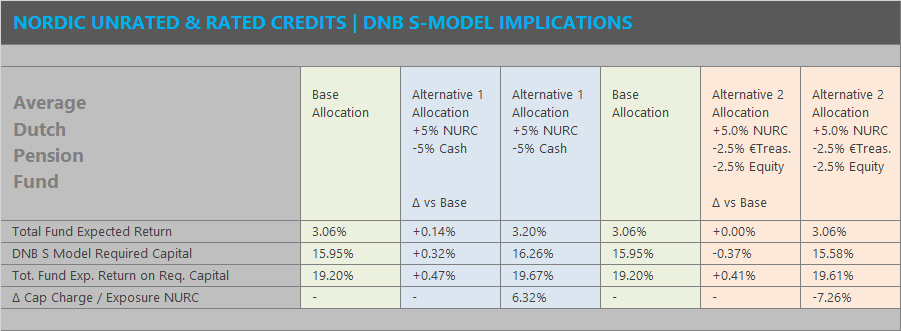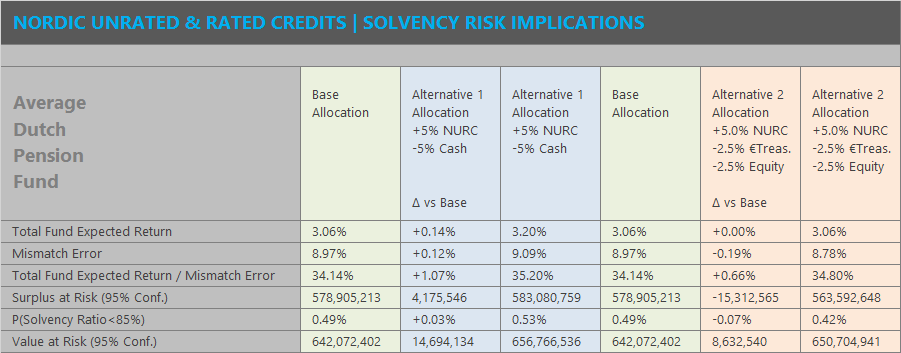On the 25th of May 2022 the Finnish asset manager EVLI presented at the FFH annual institutional investor event making the case for Nordic Unrated & Rated Credits (NURC). Van Stuijvenberg Financial Services (VSFS) looked into this asset class from the perspective of a typical Dutch pension fund. Below you find a quick overview of this analysis.

Although the Dutch are moving towards a new pension system the current regulatory framework still is important. In the current regulatory framework an allocation to NURC would impact the pension fund’s required capital (solvency buffers) as calculated by the so called DNB S-Model. Some pension funds have a high solvency ratio and are not constrained by the DNB S-Model while for others the buffer requirements are a true constraint. For the latter group the impact on required capital is an important variable when making the decision to invest in NURC. Basically – like an insurance company – these pension funds try to optimize the return on required capital.
As a first step VSFS looked into the regulatory repercussions of allocating to NURC. Analyzing the impact from a regulatory perspective VSFS considered 2 alternatives for implementing a NURC allocation:
- Fund a 5% allocation to NURC from cash.
- Fund a 5% allocation to NURC from € treasuries and equities – in a 50/50 ratio – while keeping the liabilities hedge ratio constant at 60%.
In alternative 1 – funding from cash – the total expected return for the typical pension fund goes up from 3.06% to 3.20%. The required capital though rises too from 15.95% to 16.26%. Because the total fund expected return rises sharper than required capital the return on required capital increases from 19.20% to 19.67%. This makes that – from a regulatory perspective – it can be interesting to invest in NURC (funded by cash) since doing so improves the return on required capital.
Some pension funds might be extra constrained and therefore not eligible to raise the DNB S-Model required capital. When making investment decisions they must always make sure required capital does not increase. For these pension funds alternative 2 – funding from € treasuries and equities – is a possibility. In this alternative the expected return stays at 3.06% while required capital goes down to 15.58% implementing an increase in the return on required capital to 19.61%.
Looking at the 2 alternatives above VSFS concludes that NURC is an intersting asset class from a regulatory perspective. One can increase the return on required capital by investing in NURC and depending on the pension fund’s situation and appetite one can choose to increase or decrease capital requirements.
So far for the regulatory point of view… As a next step VSFS looked into the impact on solvency risk and the expected return / solvency risk ratio. Here solvency risk is measured by the mismatch error which is the tracking error of the total pension fund’s assets vs it’s liabilities priced at the so called Dutch UFR discount curve. Also from this perspective allocating to NURC can be fruitful.
Looking at alternative 1 again – funding the NURC allocation from cash – the expected return goes up from 3.06% to 3.20%. The mismatch error increases from 8.97% to 9.09%. Since the expected return shows a sharper increase than the mismatch error the expected return / mismatch error ratio goes up from 34.14% to 35.20%. Here the 5% allocation to NURC funded from cash improves the expected return / solvency risk ratio making it a sensible, effcient decision.
As discussed alternative 1 might not be possible for all pension funds because of regulation. Alternative 2 – funding NURC from € treasuries and equities – is an option for all pension funds and keeps the total fund expected return equal while reducing mismatch error. This results the expected return / mismatch error ratio to increase to 34.80%. Here again allocating to NURC is beneficial from a total return / solvency risk perspective.
Based on this case study VSFS concluded that for a Dutch pension fund it’s certainly worthwhile to consider allocating to NURC. On the regulatory side one can improve the return / required capital ratio while from a solvency risk point of view one can improve the return / solvency risk ratio. The tables below show the key findings for a typical Dutch pension fund. For most pension funds the findings will be similar but of course depend on it’s specific assets and liabilities.


If you are interested in an custom analysis based on your pension fund’s situation please reach out to:
- Jan Willem van Stuijvenberg at jw@van-stuijvenberg.com
- Richard Crombach at richard.crombach@tcp-global.com
This short article was first posted on July 12th 2022 at van-stuijvenberg.com
